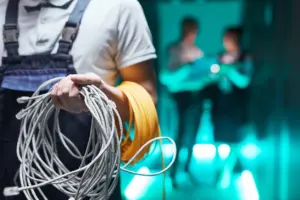Sound Masking 101: History & Advancements
Noise distractions in the workplace can greatly reduce productivity and privacy. With the rise of open office layouts and hybrid work environments, sound management solutions have become essential. Sound masking, in particular, helps reduce the intelligibility of background noise and conversations, offering a cost-effective alternative to more invasive soundproofing techniques. But how did this technology evolve, and what advancements have shaped it into the sophisticated systems we use today?
The Concept of Sound Masking and Its Role in Speech Privacy
Sound masking is the process of adding a low-level background sound, similar to white noise, that reduces the clarity of conversations and other distracting noises. This additional sound creates a more private and productive workspace by minimizing the distraction caused by background noise. It is especially useful in environments where speech privacy is critical, such as corporate offices, healthcare facilities, and financial institutions.
Sound masking doesn’t eliminate noise but rather blends it into the background, making it less noticeable to listeners. The system emits a sound at a similar frequency to human speech, masking conversations without introducing discomfort. By reducing distractions, sound masking improves concentration and enhances productivity.
The Origins of Sound Masking: Early Innovations
The history of sound masking dates back to the 1960s when early systems were designed primarily for government facilities and defense environments where safeguarding sensitive conversations was paramount. These early sound masking systems used basic white noise technology to manage noise and ensure privacy. However, they were limited in flexibility, offering little customization for specific environments.
As the demand for improved privacy in commercial environments grew, sound masking technology began to be adopted in offices, hospitals, and other areas where noise control was necessary. By the 1970s, the introduction of more flexible, decentralized systems allowed for greater customization across various spaces.
Evolution of Sound Masking Systems: From Centralized to Hybrid Approaches
Centralized Systems
The first sound masking systems employed a centralized architecture, where all sound generation and control equipment was located in one central area, such as an equipment closet. The system controlled large zones with uniform settings across all loudspeakers in each zone, making it difficult to fine-tune specific areas. These systems were best suited for large, open spaces but lacked the flexibility to address smaller, acoustically diverse areas.
Decentralized Systems
By the mid-1970s, decentralized architecture emerged, allowing for more precise control. In decentralized systems, sound generation and control electronics were integrated into each loudspeaker or small clusters of loudspeakers, allowing for finer volume control in smaller zones (e.g., one to three speakers per zone). This helped maintain more consistent sound masking levels across a facility by addressing the unique acoustic needs of individual spaces.
Decentralized systems allowed technicians to make localized adjustments, but they still required manual tuning at each loudspeaker, making it time-consuming to implement changes following alterations in the workspace, such as new partitions or changes in occupancy.
Networked Systems
The introduction of networked sound masking systems represented a significant leap forward in flexibility and control. First introduced in the 2000s, networked systems combined the benefits of decentralized architecture with centralized control. Using software or control panels, technicians could make global and local adjustments to sound masking settings, allowing for seamless tuning across the entire facility.
These systems were designed to adapt to changing environments, enabling quick adjustments when the layout or occupancy of a space changed. Networked sound masking systems also allowed for much finer control over volume and frequency settings, providing more consistent masking performance and comfort across different areas.
Advancements in Sound Masking Materials & Design
The materials used in sound masking systems have evolved significantly over time. Early systems relied on mechanical noise generators, while modern solutions use specially engineered speakers that emit targeted frequencies designed to mask human speech. This advancement ensures more effective and comfortable sound masking, which can be tailored to fit any environment.
Moreover, today’s systems incorporate advanced algorithms to create a consistent and evenly distributed sound field, ensuring optimal performance in both open-plan offices and private rooms. These improvements allow for seamless integration into the workspace, maintaining productivity and speech privacy without disrupting the aesthetic or requiring significant structural changes.
The Future of Sound Masking: Tailored Solutions for Modern Workplaces
As workspaces continue to evolve with open floor plans and hybrid work models, the need for adaptable sound masking solutions will only increase. New technologies, such as AI and machine learning, may further improve the flexibility and effectiveness of these systems by automatically adjusting sound levels based on real-time changes in noise and occupancy.
Organizations that implement advanced sound masking solutions will be better equipped to meet the demands of modern work environments, ensuring that their employees can maintain focus and productivity while enjoying a comfortable, private workspace.
From its origins in the 1960s to today’s advanced hybrid systems, sound masking has proven to be a vital tool for improving workplace environments. As office designs continue to evolve, the role of sound masking in ensuring privacy and productivity will only become more important. By adopting modern sound masking solutions like those offered by Lencore, organizations can create spaces that foster collaboration while protecting speech privacy.
Check Out Our Other Sound Masking Blogs

Maximize Your Investment: Integrate Paging into Your Sound Masking System
When a client starts planning for a sound masking system, they are usually focused on reducing distractions and improving speech privacy. But if you are already investing in a system that reaches every corner of your space,

Master Certified Installer Spotlight: Sean McGrath of Birkstone Services
When it comes to creating comfortable, private, and productive workspaces, sound masking has become a crucial part of modern building design. Few understand this better than Sean McGrath, owner of Birkstone Services, a structured cabling company with

White Noise vs Brown Noise vs Pink Noise
Every sound we hear is made up of frequencies, and not all noises are created equal. When comparing white noise vs brown noise vs pink noise, the difference lies in how each spreads its energy across the
